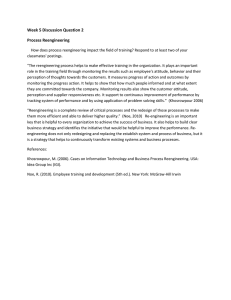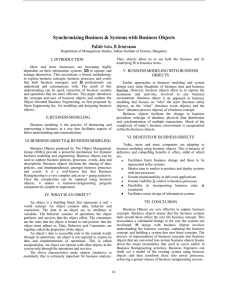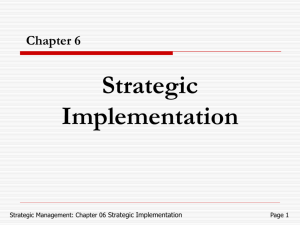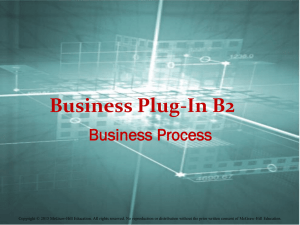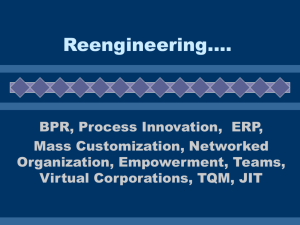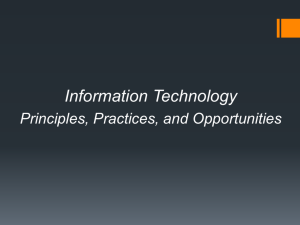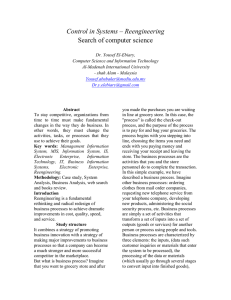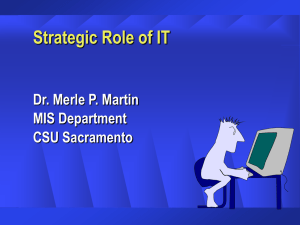Chapter Thirteen
advertisement
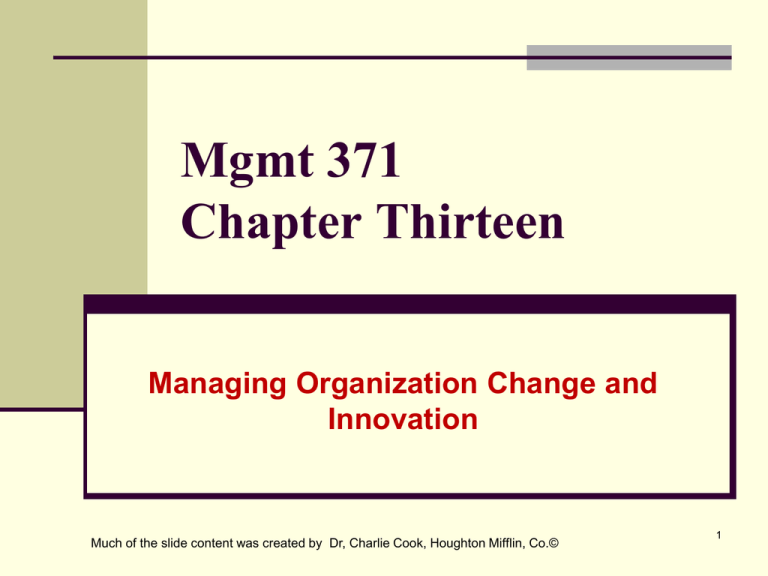
Mgmt 371 Chapter Thirteen Managing Organization Change and Innovation Much of the slide content was created by Dr, Charlie Cook, Houghton Mifflin, Co.© 1 The Nature of Organization Change Organization Change Any substantive modification to some part of the organization (e.g., work schedules, machinery, employees). Forces for Change External forces in the general and task environments that force the organization to alter the way it competes. Internal forces inside the organization cause it to change its structure and strategy. Some internal forces are responses to external pressures. 2 Classifications of Organization Change Planned Change Is designed and implemented in an orderly and timely fashion in anticipation of future events. Reactive Change Is a piecemeal response to events and circumstances as they develop. 3 Managing Change in Organizations Three Step Change Process Model (Kurt Lewin) Unfreezing Individuals must be shown why the change is necessary. Implementing change The change itself is implemented Refreezing Involves reinforcing and supporting the change so that it becomes a permanent part of the system. 4 Steps in the Formal Change Process 5 Understanding Resistance to Change People resist change because of: Uncertainty about the extent and effects of change. Threats to self-interests and power and influence. Different perceptions of change effects and outcomes. Feelings of loss in disrupted social networks, power, security, and familiarity with existing procedures. 6 Overcoming Resistance to Change Techniques for overcoming resistance to change: Encouraging active participation in the change process. Providing education and communication about the change process. Facilitating the change process by making only necessary changes, announcing changes in advance, and allowing time to adapt to change. 7 Overcoming Resistance: Force-field Analysis for Plant Closing at GMC 8 Areas of Organization Change 9 Reengineering in Organizations Reengineering The radical redesign of all aspects of a business to achieve major gains in cost, service, or time. Focus is on identifying & eliminating marginal activities. Downsizing (a.k.a., Right-sizing) - Intentional reduction of the workforce. May result from closing facilities. Avoid organizational anemia. 10 Reengineering in Organizations Need for Reengineering Entropy occurs as the maintenance of status quo puts an organization out of synch with its environment, and it starts consuming its own resources. Approaches to Reengineering Recognizing the need for change and acting on it with a sense of urgency. Starting with a clean slate to open up the process. Using a blend of top-down and bottom-up involvement. 11 The Reengineering Process 12 Organization Development (OD) Organization Development A planned, organization-wide effort, managed from the top, that is intended to increase organizational effectiveness and health through interventions in the organization’s processes using behavioral science knowledge. 13 Organization Development (OD) OD Assumptions Employees desire to grow and develop. Employees have a strong need to be accepted. Individuals will influence the organization and the organization will influence individuals 14 Organization Development Techniques Diagnostic Activities Technostructural Team Building Activities Survey Feedback Process Consultation Education Life and Career Intergroup Activities Third-Party Peacemaking Planning Coaching and Counseling Planning and Goal Setting 15 The Innovation Process 16 Forms of Organizational Innovation Radical Innovation Fundamentally changes the nature of competition in an industry. A new product, service, or technology developed by an organization that completely replaces the existing product, service, or technology in an industry. Incremental Innovation Does not significantly affect competition in an industry. A new product, service, or technology that modifies an existing one. 17 Forms of Organizational Innovation (Technical v. Managerial Innovations) Technical innovation A change in the physical appearance or performance of a product or service, or the physical processes through which a product or service is manufactured. Managerial innovation A change in the management process by which products and services are conceived, built, and delivered to customers. 18 Forms of Organizational Innovation (Product v. Process Innovations) Product innovation A change in the physical characteristics or performance of existing products or service or the creation of brand-new products or services. Process innovation A change in the way a product or service is manufactured, created, or distributed. 19 Effects of Product and Process Innovation on Economic Return 20 Innovation Reasons for Failing to Innovate Lack of resources Failure to recognize opportunities Resistance to change 21 Innovation Promoting Innovations in Organizations Using the reward system Having a supportive organizational culture Encouraging intrapreneurship in larger organizations Inventors Production champions Sponsors 22

